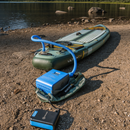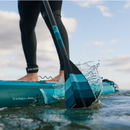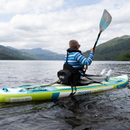How to Stand UP Paddle Board: The Complete Guide for Beginners

The popularity of the stand-up paddle board sport is rapidly expanding. The industry was estimated to be worth $2.6 billion worldwide in 2023 and nearly $500 million in North America in 2017. The paddle board retail sales had increased by more than 20% in 2020. Surveys show that over 22 million Americans learnt and practiced how to paddle board last year. With around half of paddle boarders holding college degrees, the sport has become a popular leisure activity among young adults.
To master this watersport, you need to have proper gear and techniques. This article will help you prepare the necessary equipment and provide useful paddle board tips for beginners. Follow along!
Safety Guide - The Complete Paddle Board Gears
Stand up paddle board beginners should ensure they have the following items to start practicing the sport.

Here is a full list of gears:
- Paddle board: Paddle boards designed for touring are long and thin, with a pointed nose that makes for smoother glides and straighter water tracks.
- Paddle: The all-carbon paddle is lighter than the carbon nylon mix option, reducing fatigue and allowing greater exploration.
- Leash: The leash is a safety gear that keeps you to your paddle board's anchor point. In the event of a fall, it prevents the board from drifting and protects it from weather hazards and other dangers.
- PFD: A personal flotation device (PFD) is a crucial emergency safety tool, especially if you’re a paddle board beginner. You’d better go for waist belt PFDs since they provide comfort and mobility and ensure there’s an attached emergency whistle.
- Pump & repair kit: Although inflatable paddle boards are strong and unlikely to puncture, longer paddle boarding journeys may require the use of a pump and repair equipment.
- Dry bags/Waterproof deck bags: These bags are designed to keep your gear dry while you enjoy the sport.
- Hiking shoes/sandals: Lightweight trainers or sandals are beneficial for barefoot paddlers on rocky waterbed surfaces. Avoid fully waterproof shoes as they take longer to dry.
- Comfortable clothing: Choose the outfit that you feel comfortable with during the journey. Breathable, quick-drying materials for summer and wetsuits for colder days are highly recommended.
- Sun hat & sunglasses: Due to the sun's intensifying effects in water, paddlers should wear sunglasses, caps or wide-brimmed hats.
- Travel towel/Towelling robe: Bring a towel or robe in case you fall into the water. The towel can also be used as a picnic blanket for lunch breaks.
- Water bottle: Keep yourself hydrated by preparing an insulated flask or cooler for cold drinks, and consider using a built-in bottle or water filter for a longer journey.
- Sunscreen & insect repellent: Sun rays near water can cause skin burns, so carry a high-SPF, water-resistant sunscreen and reapply it throughout the day. Also, apply insect repellent and stay away from insects that thrive in humidity, such as midges.
- First aid kit: Outdoor excursions often require a basic first aid kit. For water-related activities, like paddle boarding, use dry bags or waterproof pouches to keep the inside items dry.
- Snacks: Protein bars are a healthy, high-energy option to keep your level up during the activity. Put them somewhere easily reachable for the best convenience.
How to Paddle Board: Basic Techniques for Beginners
Here are the basic instructions on how to stand up paddle board for beginners.
1. How to Stand Up?
Whether you’re a paddle board beginner or an expert, you need to master the standing-up technique to enjoy the sport to the fullest. A world of excitement awaits you on the water with improved balance, stability, and confidence that comes from consistent practice and appropriate standing up posture.

Here’s how you can do it:
- Stand beside the board in shallow water.
- Put your paddle on the deck.
- With one hand, hold onto the rails of the board.
- Just behind the board's center, kneel and climb atop it.
- Check the balance point on board where the tail does not dig in water and the nose does not pop out.
- Stabilize the board with hands on either side.
- Step up by putting your feet where your knees were, one foot at a time.
2. How to Practice Proper Stance and Posture?
The next step in learning how to paddle board for beginners is practicing proper stance and posture.
a. Proper StanceProper foot placement and posture in the SUP stance are essential for maintaining balance and control. Stand up paddle board beginners often make mistakes by standing too far forward or backward, making it challenging to maintain balance.

Useful beginner paddle board tips for foot placement:
- Step your feet shoulder-width apart over the carry handle of your paddle board.
- When standing with your feet parallel, slightly tilt them outward by about 15 degrees.
- For optimal balance when paddling, equally distribute your weight across both feet.
- Avoid gripping toes to keep balance.
b. Proper Posture
Improper SUP standing can cause back strain and poor paddling habits. To improve your SUP posture, avoid excessive knee bentness and back hunching, and follow these paddle board beginner tips.
- Slightly bend your knees so your toes can be visible.
- Avoid letting your knees bend too inward or outward during your paddle stroke.
- Maintain a straight back at all times.
- Always keep your eyes on the horizon
- Remember to always engage your core.
3. How to Practice Basic Stroke?
One important thing you need to know while learning how to paddle board is to master these three types of strokes.
a. Forward strokeIt’s the stroke moving your board through the water faster. You should:
- Plant the paddle in the water and push the blade under the surface.
- Return the paddle to your ankle in the water and then lift it out.
- Maintain a straight-arm posture while twisting from the torso.
- Don’t pull the paddle back, but use your top hand to press down on the grip.
- Alternate strokes on either side of the board to create a straight line. 3-4 strokes per side are enough.
- You will go straighter if you maintain the paddle at a more vertical position.

b. Reverse stroke
Reverse stroke is the opposite of forward stroke and is used to slow down, turn, or stop the board. You can easily do it by following these paddle board tips for beginners:
- If you paddle on the right, reach backwards and place your paddle in the water close to your board's tail. The blade should be fully under the water.
- Maintain your arms straight and twist from your torso like you do with the forward stroke.
- Your board’s nose will turn to the right when you do the reverse stroke on the right side of your board, and vice versa.
c. Sweep stroke
Whether you stand or move, sweep stroke is a useful technique to turn your board.
- If your paddle is on your right side, rotate to bring your right shoulder forward.
- Push your paddle forward so that the whole blade is submerged in the water.
- Use your knees and hips as leverage and rotate your body to sweep the paddle away from the board in an expanse from the nose to the tail.
- If you perform the sweep stroke on the right side, your board will turn to the left, and vice versa.
4. How to Fall Off and Get Back Techniques?
It’s normal for stand-up paddle board beginners to lose balance often. Below is how you can deal with the situation:
a. How to Fall offThe techniques you should know when falling off a paddle board:
- Let yourself fall away: It's crucial to fall away from the board, as grabbing it can cause injury. If you start to feel unsteady and realize you're going to fall, decide to let go and veer to the side, either the front or the back of the board.
- Land flat on the water: Use a belly or back flop to maintain shallowness and fall flat. It reduces the risk of hitting underwater objects.
- Hang onto the paddle is possible: It’s better to hold onto your paddle while falling. However, if you can’t, it’s fine. You can get it back after getting back on your board and paddling with your hands.
- Be careful with your board: Paddling with a board leash is always advised, but if you use a coiled leash, your SUP may return to you more quickly when you fall. You can use your hands to cover your face in case.
b. How to Get back
Here is how you get back to your board after swimming back:
- Grab the carry handle, take a position close to the board's center, and raise yourself up till your other hand reaches the rail on the other side.
- To slide onto the board, pull on the handle and rail while you kick your legs to bring them up to the surface behind you.
How to Start Your First Paddle Boarding Adventure

Follow these basic steps to catch waves for the first time:
- Bend your knees: First, you should feel the balance by placing your knees on the board before standing on your feet. While standing, bend your knees and look forward. Remember not to bend at the waist.
- Mind your hips: Avoid swaying your hips or shifting your weight from side to side.
- Hold your paddle: Put one hand on the top of the handle and the other below. Keep a comfortable distance between two hands and avoid overstretching.
- Start paddling: Put the blade under the water at a point that you can easily reach ahead of you and then pull it back.
- Approach waves: Bend your knees and keep paddling to move forward in balance.
- Control balance: If you lose balance, you can regain it by bending your knees even more and keeping the paddle blade flat on the water.
- Size up your board: It’s better for a paddle board beginner to practice with a wider board since it offers more stability and balance.
- Use a leash: One of the paddle board tips for beginners you should know is using a leash. The accessory can secure your feet to the board, benefiting your stability.
Additional Tips to Smooth Paddle Board Experience
Now, let’s continue with additional paddle board beginner tips to have a seamless experience!
- Turning techniques: The rule is simple. Paddle on the left if you want to turn right and on the right if you want to turn left. Other useful turning techniques include stepping back on the board or turning to face the direction of your turn.
- Maintaining Balance on Your SUP: It’s common for a paddle board beginner to keep balance by the upper body. However, it’s a mistake, and you should use your hips instead.
- Carrying paddle board technique: When you need to travel long distances and there’s no handle, carrying your paddle board on your head is a good option.
- Standing on a paddle board: At first, kneeling on the board may be more comfortable than standing upright. Plus, having a companion there might assist with stabilizing the board until you get used to it.
- Optimal paddling focus: Remember that your abdominal muscles are stronger than those in your arms. So, focus more on that area.
- Caring and protecting tips: Avoid dragging the board or laying its fin side down.
- Using paddles properly: Keep in mind that your paddle is not for pushing off. Use it properly for a long lifespan.
Improve Paddle Board Skills with iROCKER
Learning how to paddle board is not too difficult. You can master it if you follow the instructions properly and conduct regular practice.

You can start your first step by choosing a suitable stand up paddle board. iROCKER offers a wide range of high-quality products to ensure safety and a smooth experience when paddle boarding. Visit our website for more detailed options!






